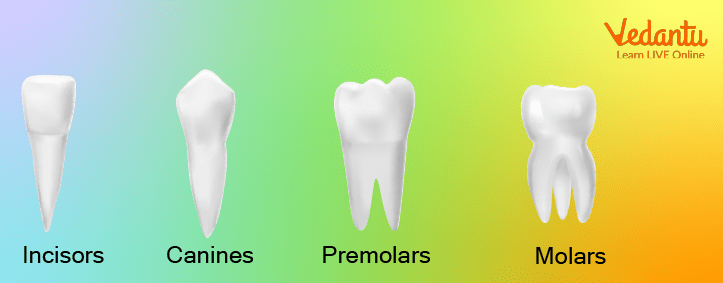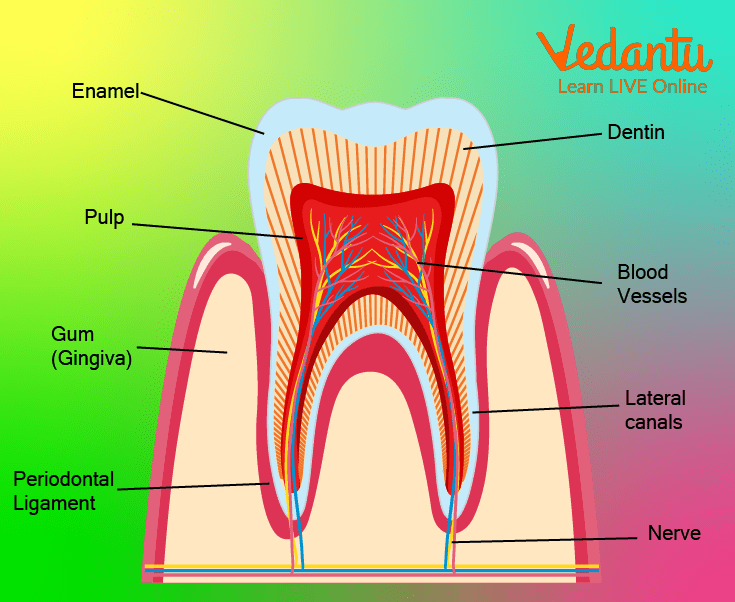




Introduction About Teeth
Many vertebrates, or animals with spines, have teeth inside their mouths. Teeth are hard, bony designs that develop from the jawbone. People and different animals use their teeth to chew and bite food.
We will get to learn about types of teeth for kids. By cutting, tearing, and crushing food and by the help of mixing it in with saliva, teeth do the most important part in the digestion of food that we eat. This is known as mastication. The teeth of people likewise help in speaking and producing sound, and they also make us look beautiful.
Teeth for kids are of various shapes and do different work. Chisel-shaped incisors, the front teeth in the human mouth, help to bite and cut food. The sharp cuspids, the canine teeth, are used for tearing and destroying. Bicuspids are double-pointed teeth and help to tear and crush food. Molars have broad surfaces for grinding and crushing our food. We will look into all sets of teeth.
Types of Teeth
Teeth of various shapes do various positions. Front teeth, called incisors, bite and cut. Pointed teeth, called cuspids or canines, tear and shred. Teeth with two cusps, called bicuspids, tear, and crush. Back teeth, called molars, grind and crush. In the same way as other different warm-blooded animals, people have two arrangements of teeth during their lives.
How Many Teeth does a Child have?
The primary set comprises 20 teeth. These are called primary, or child, teeth. At the point when a kid is around 6 years of age, these teeth start to lose and drop out. Throughout the following eight years 28 permanent teeth supplant all the child teeth. These are a set of teeth a human being has. At the point when an individual is around age 20, four additional molars, called wisdom teeth, come in. Many individuals have their wisdom teeth eliminated to keep their different teeth straight. This justifies how many teeths does a child have.

Types of Human Teeth
Tooth Structure
The visible piece of a tooth is known as the crown. A few layers make up the crown. The external layer is a hard white covering called enamel. Enamel safeguards the tooth from destroying. Underneath the enamel is dentin. This yellow, bone-like material is softer than enamel. Dentin makes up the biggest piece of the tooth.
The centre point of a tooth is known as the pulp. The pulp is a delicate tissue that contains blood and nerves. Nerves in the teeth convey messages to the cerebrum about intensity, cold, or pain.
The delicate tissue around the base of every tooth is known as the gum. The roots of the teeth lie beneath the gums. A tooth has somewhere in the range of one and three roots. A glue-like substance called cementum covers the roots. The cementum keeps the teeth intact in the jawbone. Have a look at a simple teeth diagram. Types of teeth are explained below.

Simple Teeth Diagram
Problems with Teeth
A typical issue with teeth is tooth rot or holes. Microscopic organisms in the mouth structure a tacky film called plaque. As plaque develops on the teeth, it destroys the tooth enamel. The loss of enamel, called a cavity, may cause pain and disease.
Teeth in Other Animals
The teeth of all vertebrates are approx. same, however, the shape of the crown and root fluctuates among various animals. Numerous animals have teeth that are adjusted for extraordinary purposes. Rodents, bunnies, and rabbits have bent incisors that are set profoundly inside the jaw and develop persistently.
Primates have extended canines that they use for protection and show. Snake teeth are empty teeth that carry on like needles through which they convey toxins.
Summary
Look into your mouth and observe all types of teeth you have. Count how many teeth are there in your mouth. Learn the use of all different types of teeth. You can also observe your friend's tooth.
Dental specialists fill cavities with metal or plastic to forestall further harm. Plaque can likewise make gums red, sore, and frail. Over the long run, weakened gums can wear out up to the point that the teeth drop out. Regular tooth brushing, flossing, and visits to a dental specialist can solve these issues.
The tusks of elephants are augmented upper incisors. The tusks of walruses and wild hogs are extended canines.
FAQs on Teeth for Kids
1. Write a note on the arrangement of human teeth.
The first set of teeth is called primary teeth, and is present in children. Each adult jaw contains a set of four incisors, which are used for biting. These four are covered on both sides by single canines, and sharp tearing teeth, which are much longer in carnivorous animals like lions and tigers. Towards the rear of the jaw is a pair of premolars and then three larger molars on each side. During biting and chewing, a near-perfect placement of upper and lower sets of teeth is vital for efficiently processing ingested food.
2. How many teeth do humans have?
Humans are diphyodont, which means that we possess two successive sets of teeth in our lifetime – the milk teeth and permanent teeth. Children usually have 20 milk teeth which get gradually replaced by 32 permanent teeth as they mature. The primary set comprises 20 teeth. These are called primary, or child, teeth. At the point when a kid is around 6 years of age, these teeth start to lose and drop out. Throughout the following eight years 28 permanent teeth supplant all the child teeth. At the point when an individual is around age 20, four additional molars, called wisdom teeth, come in.
3. How many molars do kids have?
A child's mouth has 20 initial teeth, also called primary teeth, baby teeth, or deciduous teeth: Four second molars. Four first molars. Four cuspids (also called canine teeth or eyeteeth)









